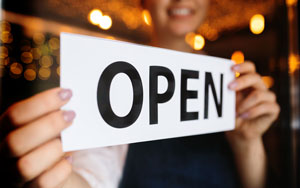 by Kevin Grauman
by Kevin Grauman
The reopening of in-person commerce is finally a reality we can celebrate. Unfortunately, this pandemic is not over, and it may be months — or even longer — before we are in the clear. Until then, it is up to each store to maintain a safety standard that will allow for the resumption of life as we knew it. But what does that really mean?
For starters, it goes beyond laying tape on the ground so people know where to stand, or watching for people with masks dangling from their ears. Making the shopping experience appealing and safe for consumers will require stores to reduce overcrowding by moving people in and out faster. But for independent retailers, reputation is paramount. A store that “rushes” people will not be around long, especially in the age of Yelp and Google Reviews.
The good news is that maintaining both a manageable flow of shoppers and fostering customer relationships are not mutually exclusive. With the right technology in place, stores can strike a balance. For example, some companies have developed tools that provide real-time information on a given location’s crowd density. Tools like this enable a store owner or employee to identify when they can permit people to linger and when they need to “move things along.”
Building Connections
In retail, if there is any COVID-19 silver lining to speak of, it is that quarantines have made us all realize the value of community, which independent retailers provide every day. With the onset of warmer weather here in North America, retailers can foster interpersonal interactions in front of a store rather than indoors where the coronavirus spreads more easily.
Geofencing is a technology that pushes an alert to a consumer when a product that may interest them is in stock at a nearby store. The consumer can then make a purchase from their smartphone and a store can have it waiting as soon as the customer arrives by appointment, whether that’s 15 minutes or three hours later. By staggering appointments, there is an opportunity for the retailer to create a social but not overcrowded atmosphere in the outdoor pick-up area.
Many independent retailers will have to make do with fewer employees taking on more responsibilities, which can result in longer lines at the counter. Waiting in a line for a few minutes at the right place can be enjoyable. Waiting for 10 minutes or longer is tedious, but this does not need to be a fait accompli.
California-based QLess has developed a customer interaction (CIM) tool that allows retailers to offer virtual check-ins through a dedicated online portal with real-time SMS updates about wait times and placements in line. As in the case with geofencing technology, consumers are empowered to set pick-up appointments based on their own schedules and tolerance for lines.
The opportunity for meaningful encounters that create lasting communities is a huge reason why many storeowners went into business and why people choose independent stores when there are so many other options. Providing these moments may require strategies that are less conventional, but doing so will be no less rewarding. The investments stores make in technology that allows for safe and enjoyable in-person experiences, whether inside or curbside, will pay for themselves — and then some.
Kevin Grauman is CEO of QLess, a pioneer in virtual lines and digital crowd management. He was named as one of the 100 Superstars of HR Outsourcing in the USA by HRO Today magazine and is also the recipient of the Ernst & Young Entrepreneur of the Year award.
